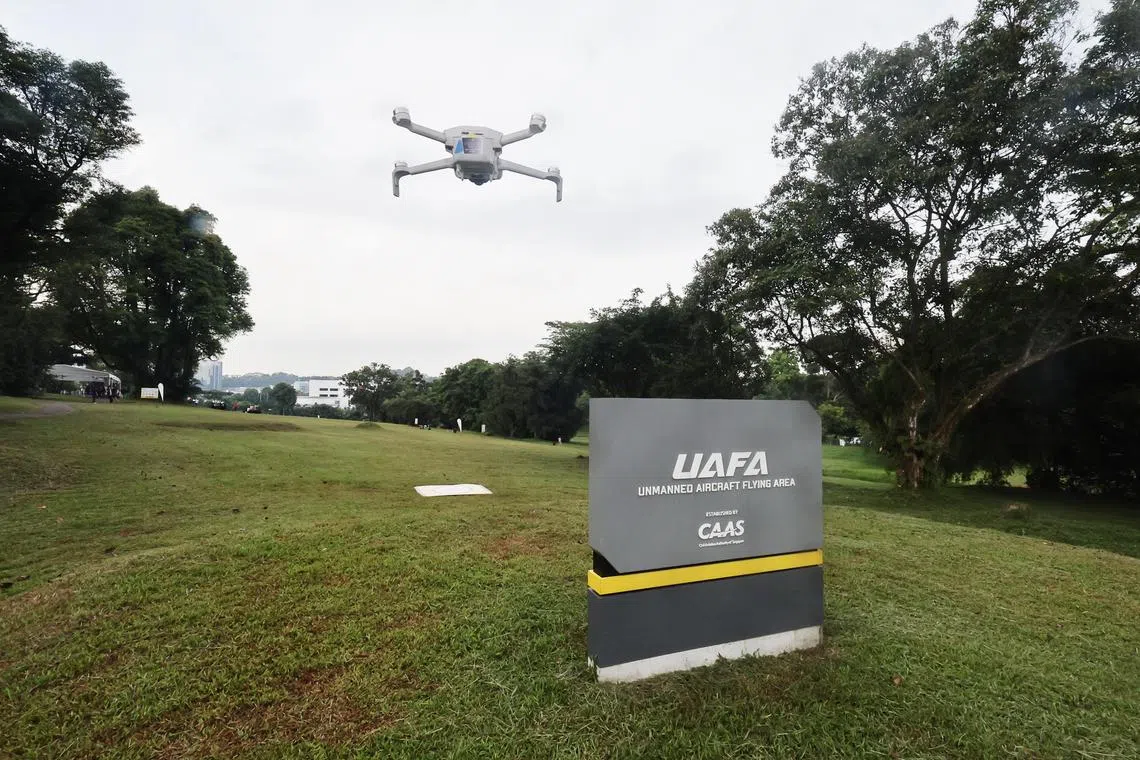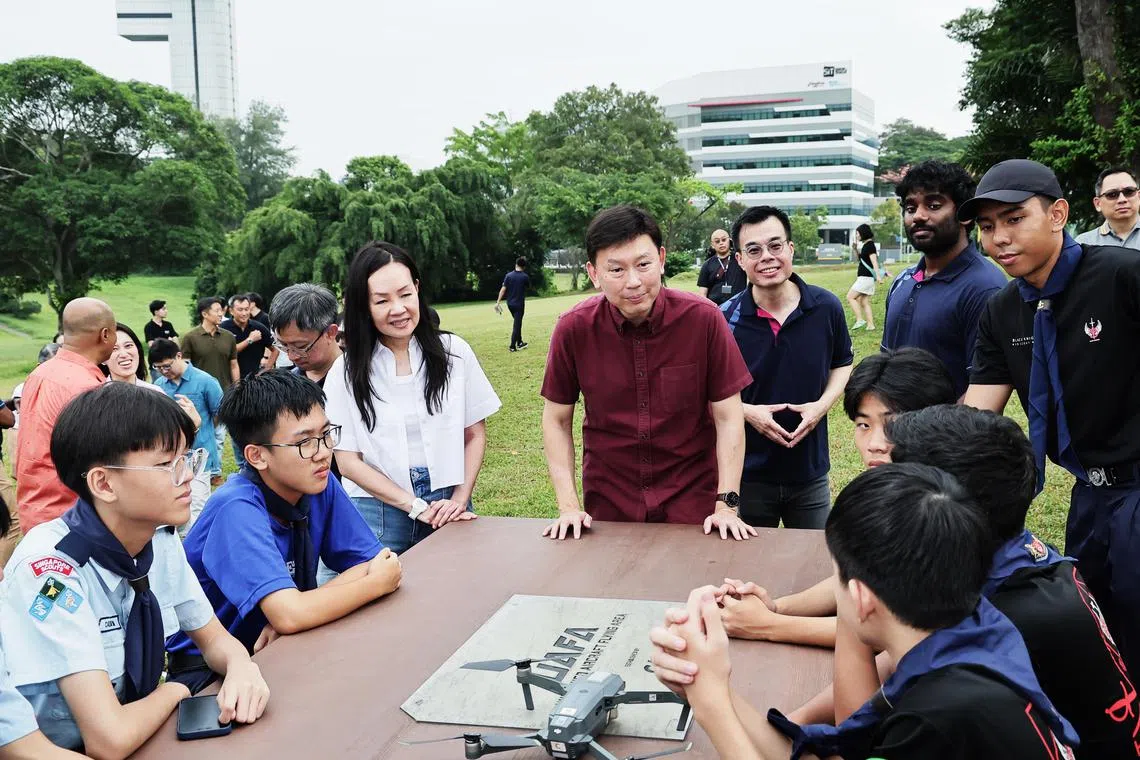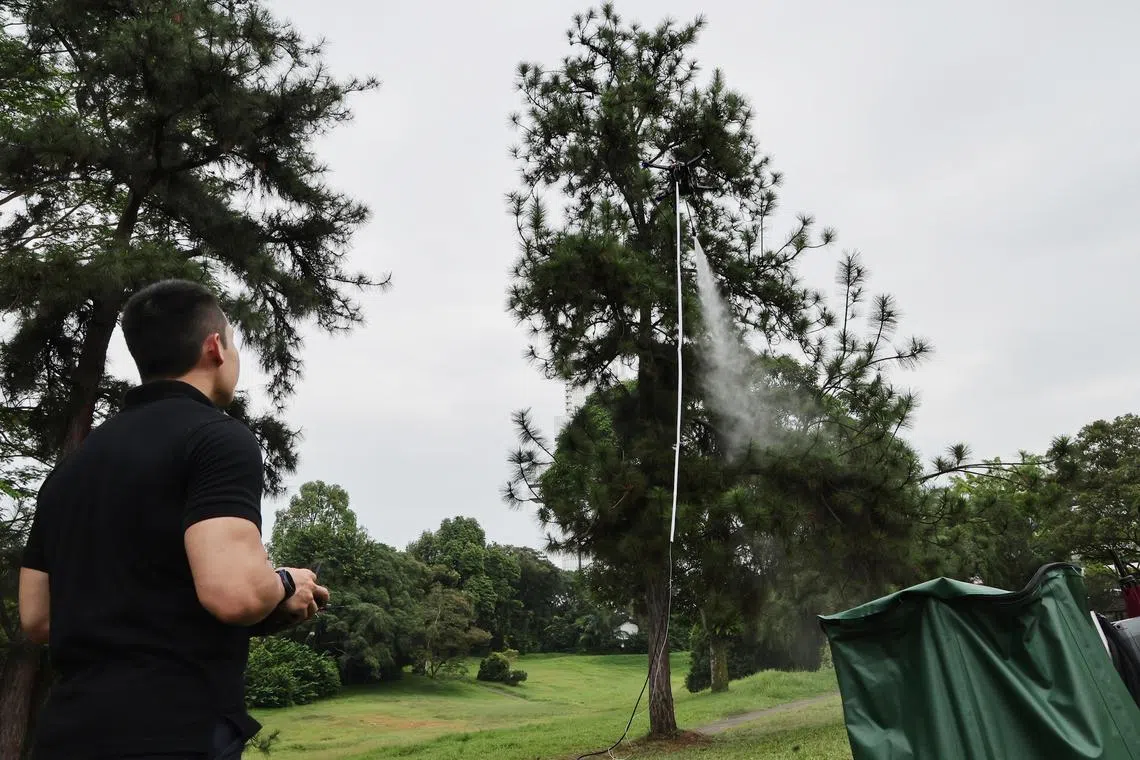New dedicated area for drone flying opens in Dover Road
Sign up now: Get ST's newsletters delivered to your inbox

The Unmanned Aircraft Flying Area in Dover Road measures 0.6ha, roughly the size of a football field.
ST PHOTO: KELVIN CHNG
Follow topic:
SINGAPORE – The latest Unmanned Aircraft Flying Area (UAFA), which was launched on July 6 across from Singapore Polytechnic in Dover Road, “is a blessing”, according to a group of aeronautical engineering students there.
Mr Moe Yan, 20, who researches drones for plant retrieval in vertical farming, said the group previously had to compete for slots to fly their drones at the polytechnic’s multipurpose hall, or fly them at the first UAFA at Pandan Reservoir, which opened in July 2022.
“Outdoor testing is more realistic because we get to test the drone against wind interference and network latency,” said Mr Moe.
He added: “Unlike drone testing in a multipurpose hall, it is safer (to fly a drone) outdoors as there will be nobody walking under the airborne drone.”
The UAFA in Dover Road, set up by the Civil Aviation Authority of Singapore (CAAS) for flying of recreational unmanned aircraft (UA), is 0.6ha, roughly the size of a football field.
It was officially launched by Transport Minister Chee Hong Tat on July 6.

Minister for Transport and Second Minister for Finance Chee Hong Tat (centre) and adviser for West Coast GRC Grassroots Organisations Rachel Ong (in white) with scouts at a workshop introducing unmanned aircraft.
ST PHOTO: KELVIN CHNG
Basic on-site amenities include tables and benches to provide users with a comfortable place to mingle and set up their UA.
Feather flags demarcate flight boundaries, while boards give information on UA safety regulations and reminders, such as registering drones with a total weight above 250g with CAAS.
Mr Chee acknowledged that the UAFA at Pandan Reservoir, being over water, made the flying of drones a little bit more challenging for some beginners.
“If a drone were to drop on water, retrieval would be more difficult,” he said. “This location (UAFA Dover Road) offers a different experience (as) it’s over land. I think it gives more options to support an increase in demand from drone users.”
The UAFA at Pandan Reservoir
Figures from CAAS point to the popularity of UA.
In December 2022, there were 1,299 UA pilot licence holders and 18,199 registered UA.
As at March, there were 1,735 UA pilot licence holders and 24,176 registered UA.
CAAS has also conducted 12 workshops, reaching out to 139 participants from educational institutions such as Singapore Polytechnic and Ngee Ann Polytechnic, as well as residents of Ayer Rajah.
The Transport Minister also announced a revision to granting permits for a UA light show.
Previously, it cost an operator $25,000 to conduct a UA light show involving 1,000 new UA.
From July 6, UA light show operators will be charged an initial permit fee of $500. Subsequent applications for a Class 1 Activity Permit for UA light shows will cost $425, regardless of the number of UA flown.
At the event, CAAS rolled out three new programmes to engage Singaporeans on safe and responsible UA flying, in collaboration with community partners such as the Singapore Scout Association, People’s Association and Association of Drone Soccer Singapore (ADSS).
Mr Tan Kah Han, senior director of the Unmanned Systems Group at CAAS, said: “The growing interest in unmanned aircraft activities, both recreational and commercial, is a testament to the increasing appeal and versatility of unmanned aircraft.
“It underscores the need for inclusive and well-managed spaces that cater to diverse interests and skill levels, while promoting safety, education, and positive engagement within the community.”
Some guests at the launch of the Dover Road UAFA came from the shipping and engineering sectors, which regularly use tethered drones to inspect bridges or wash building windows – a practice that keeps workers safer and is cost-effective for the companies.

Tethered drones are seeing use in the shipping and engineering sectors, which keeps workers safer and is cost-effective for companies.
ST PHOTO: KELVIN CHNG
In the marine industry, drones are used to deliver spare parts from one ship to another or drop off life buoys in rescue operations, said Mr Edwin Rodrigues from Columbia Shipmanagement Singapore.
Mr Rodrigues, 53, said: “When inspecting a high mast or a ship’s tank, it takes about an hour to prepare a human inspector. A drone requires little ‘prep’ time and is almost ready to go.”
Students, scouts and residents, as well as enthusiasts who fly soccer drones, were also present at the launch.
Soccer drones, which can cost between $500 and $1,000 each, are encased in ball-shaped cages. There are five drones to a team, including a “striker” who aims to fly into a round “goal post” while being blocked by opposing “defender” drones.
In a demonstration in a netted court, the fast-moving action and high-revving motor blades remind spectators of a scene right out of the Harry Potter books and movies, in which characters play the rough sport of Quidditch.
Mr Eric Lim, 62, vice-president of ADSS, said: “Drone soccer is a fun game of strategy and is a relatively new sport in Singapore. We want to raise awareness to show that anybody can participate – even children and senior citizens.”

Members of Drone Soccer Singapore flying drone balls at the Unmanned Aircraft Flying Area at Dover Hiking Trail on July 6.
ST PHOTO:KELVIN CHNG
UA owners can register their drones for recreational, educational and business purposes. There is a fee of $25 for a registration label. Registration can be made online at https://www.caas.gov.sg/public-passengers/unmanned-aircraft/ua-regulatory-requirements
In 2023, CAAS said it dealt with 309 cases of unlawful use of drones
It added that 15 court cases resulted in fines of between $4,000 and $45,000. The remaining 294 drone operators were issued composition fines, stern warnings or advisories.
In 2022, CAAS took enforcement action against 396 cases of unlawful unmanned aircraft operations. In 2021, there were 266 such cases.


